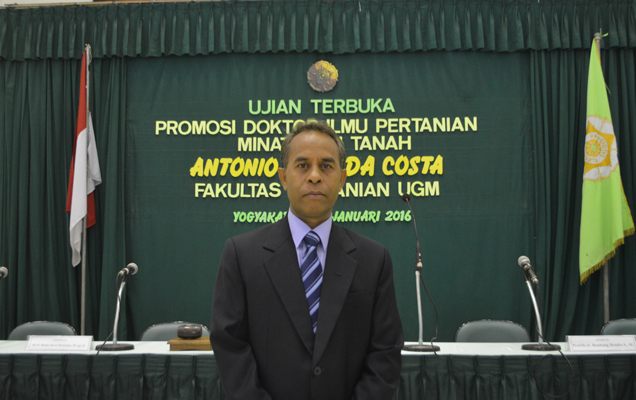
The district of Lautem in Timor Leste is a fertile soil for cultivation. Agricultural productivity in the area, however, is still minimal due to the traditional agricultural practices it receives.
The area for rice cultivation spans as vast as 43,550 ha for rice and 70,000 ha for corn. Rice production is 1.5 t ha-1 and corn 0,6 t ha-1.
“Cultivation and management of natural resources of Lautem are not yet optimal, hence a land evaluation is required,” said lecturer from National University of Timor Lorosae, Antonio Joao Da Costa on Monday (10/1) during his open doctoral exam at Faculty of Agriculture UGM.
Antonio said soil fertility of Lautem and Luro sub-districts were medium (63.6%). Despite the good soil, sloping land and erosion are two things that hamper cultivation.
The evaluation he conducted showed that rice and crops agriculture there are beyond the land suitability with the main limiting factor that is non-permanent. To increase the potential, Antonio called on farmers to cultivate on the same land unit that is within the limit of land suitability class.
Land unit of Odafuro (SPT 17) and Suruwaku (SPT 18) are prioritised for dry rice cultivation and crops whilst land unit of Atecalmor (SPT 126) for peanuts.
“Land units outside Odafuro, Suruwaku, and Atecalmor in Lautem and Luro sub-districts are prioritised for conservation areas as they are outside the land suitability class for rice and crops,” said Antonio defending his dissertation titled Land Evaluation as Development Basis for Crop Cultivation: Case of Raumoco Lautem, Timor Leste.
Antonio added rice and crop planning to be prioritised early during planting season due to water availability which needs additional irrigation during the second planting season.
“Water availability lasts very quick so it needs additional irrigation in planting planning and pattern,” he said.
On the pattern, he suggested the polyculture system on the vast land, not ignoring Mucuna plants and technology use that is compatible with land requirement.

